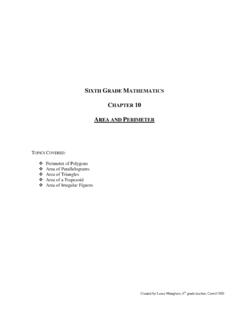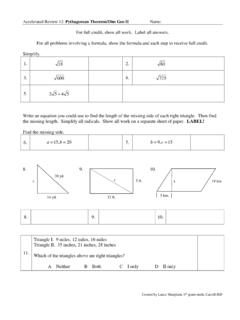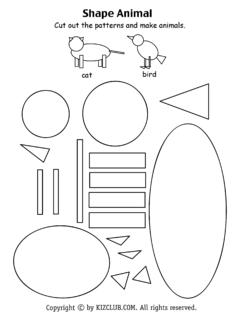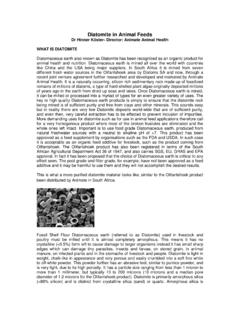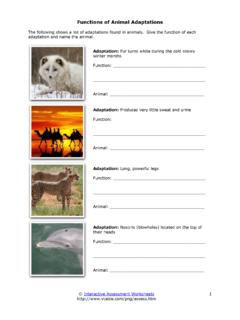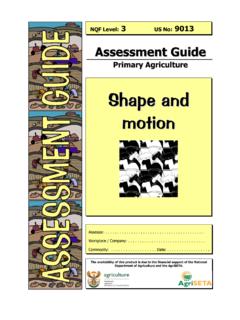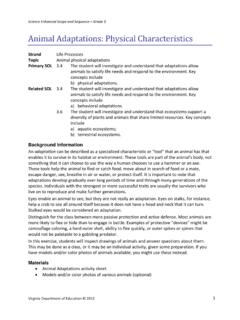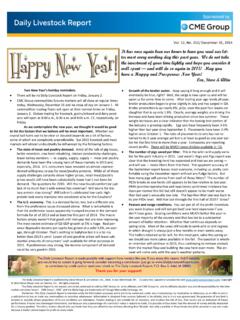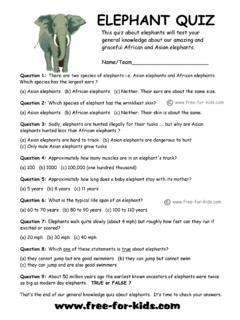Transcription of The greater the surface area-to-volume ratio of an animal ...
1 Activity 16-3: Skin and Guts Name: 10. Using what you learned in the previous problems, complete the table below. When the edge of the The surface area gets And the volume gets cube multiplied multiplied by . doubles (x2). triples (x3). quadruples (x4). goes up m times You have 3x3x3 cube and a 7x7x7 cube. What is the ratio of their 11. surface areas? Use your tables above to help. PART 2: Applying the surface area-to-volume ratio to Animals Why are flying squirrels in the Arctic more than 50% larger than those in Central America? Animals adapt to their environment. Part of this adaptation involves both an animal 's surface area and an animal 's volume. How the surface area and volume compare can tell us a lot about the different places where animals live.
2 The surface - area-to-volume ratio is also called the surface -to-volume ratio . Animals generate heat internally in proportion to their volume. The larger the volume of the animal the more heat it can produce. Animals lose heat externally in proportion to their surface area. The larger the surface area of the animal the more heat it can lose. Body temperatures of animals are usually greater than the outside temperature meaning that frequently the direction of heat flow' is from the animal to the outside, heat is lost from the animal . For a mammal heat lost to the outside, via the surface , must be replaced by heat obtained from the breakdown of food. The greater the surface area-to-volume ratio of an animal , the more heat it loses relative to its volume.
3 As animals grow in size their inside (volume) gets more bigger than their outside ( surface area). You proved this in part one when you completed table number two. As you increased the side length, the volume started growing much faster than the surface area. The larger the animal , the smaller the surface area-to-volume ratio and so the less relative area there is to lose heat. This means that for identically shaped animals of different sizes, the large one will keep its temperature more easily. Being bigger means being warmer. Created by Lance Mangham, 6th grade math, Carroll ISD. surface Area and Volume Comparison of Small and Large Animals [The surface area and volume numbers are just for comparison purposes.]. Heat flow (SA): 16. Heat generation (VOL): 8.
4 SA-VOL ratio 2:1. Heat flow(SA): 4 Heat flow (SA): Heat generation (VOL): 256. 1 Heat generation (VOL): 512. SA-VOL ratio 4:1 Heat flow (SA): SA-VOL ratio 64. :1. Heat generation (VOL): 64. SA-VOL ratio 1:1. We are small animals. We don't generate We are big animals. We generate a lot of much heat and we don't have much heat Smaller Bigger heat and we have a large flow of heat. flow. Compared to big animals, though, we Compared to small animals, though, we can lose our heat much more easily and we have a hard time losing heat which means can have a hard time staying warm. we stay warm much more easily. Created by Lance Mangham, 6th grade math, Carroll ISD. Activity 16-4: Skin and Guts Name: 12. Determine the surface area-to-volume ratio of the animals listed below.
5 Estimated surface animal Estimated surface area Estimated volume area-to-volume ratio (nearest hundredth). Mouse 6 square inches 1 cubic inches to 1. Rat 24 square inches 8 cubic inches to 1. Lemming 40 square inches 16 cubic inches to 1. Labrador 3,532 square inches 13,824 cubic inches to 1. Retriever Zebra 5,760 square inches 27,648 cubic inches to 1. Polar Bear 14,400 square inches 96,768 cubic inches to 1. Elephant 36,000 square inches 432,000 cubic inches to 1. As the animal gets larger the surface area-to-volume ratio gets . Created by Lance Mangham, 6th grade math, Carroll ISD. Activity 16-5: Skin and Guts Name: Animals generate heat internally in proportion to their volume. The larger the volume of the animal the more heat it can produce. Animals lose heat externally in proportion to their surface area.
6 The larger the surface area of the animal the more heat it can lose. 13. Which animal in #12 will generate the most heat? least heat? 14. Which animal in #12 will lose the most heat? least heat? As animals grow in size their inside (volume) gets more bigger than their outside ( surface area). You proved this in part one when you completed table number two. As you increased the side length, the volume started growing much faster than the surface area. The larger the animal , the smaller the surface area-to-volume ratio and so the less relative area there is to lose heat. This means that for identically shaped animals of different sizes, the large one will keep its temperature more easily. Being bigger means being warmer. Which animal in #10 has the biggest SA-VOL ratio and thus will 15.
7 Lose the most heat relative to its size? Which animal in #10 has the smallest SA-VOL ratio and thus will 16. lose the least heat relative to its size? Which characteristic can animals change the 17. easiest and fastest: their surface area or their volume? Explain. You will now use your surface area and volume knowledge and apply it to a wide variety of animals. Would you expect large desert animals to try to 18. minimize or maximize their surface area-to- volume ratios? Why? Would you expect large arctic animals to try to 19. minimize or maximize their surface area-to- volume ratios? Why? Created by Lance Mangham, 6th grade math, Carroll ISD. Activity 16-6: Skin and Guts Name: ELEPHANTS. An elephant has a small surface area compared to its volume. Therefore, it has a very small surface area- to-volume ratio .
8 Since elephants lose heat to their surroundings more slowly, they can overheat easily. In terms of surface area and/or volume, why do you think some elephants, like the African 20. elephant, have extremely large ears (the largest earflap in history of any animal )? MICE. A mouse has a very large surface area-to-volume ratio . It loses heat to its surroundings very quickly and must eat a lot of food to replace the energy lost. That huge metabolic rate makes for a high heart rate, and because mammalian hearts are only good for about one billion beats, that heat-replacing pace is what gives mice a live fast, die young lifestyle. Who will lose more total heat in a given period, a 21. mouse or an elephant? Why? Who will lose more heat relative to its volume, a 22.
9 Mouse or an elephant? Why? Who will need to eat the most food, a mouse or an 23. elephant? Why? Who will need to eat the most food relative to size, 24. a mouse or an elephant? Why? FOXES. In general, similar animals have different ear sizes depending on the climate in which they live. The arctic fox has much smaller ears than the 25. fennec fox, which lives in the desert. In terms of SA-VOL ratio , why? Created by Lance Mangham, 6th grade math, Carroll ISD. Activity 16-7: Skin and Guts Name: BEARS/POLAR BEARS. Some bears can almost become spherical. A sphere has the smallest surface area-to-volume ratio of any shape. While a one unit cube has a ratio of 6:1, a one unit diameter sphere has a ratio of only :1. The polar bear has stocky limbs and very short ears.
10 In terms of SA-VOL ratio , why would a bear 26. want to curl up into a ball (sphere)? Polar bears and camels are both very large animals. 27. Why does a polar bear have short, stumpy legs while a camel has tall gangly legs? A lemming (a small mouse-sized mammal of the tundra, related to a mole) is much smaller than a 28. polar bear. In terms of SA-VOL ratio , which species loses body heat more easily? In terms of surface area and/or volume, why 29. does a polar bear have very short ears? PENGUINS. In terms of surface area and/or volume, why do 30. penguins tuck in their flippers close to their bodies to help stay warm? PEOPLE. In terms of surface area and/or volume, why do people fold their arms over their chest or even sit 31. hugging their knees to their chin when they are cold?
